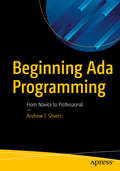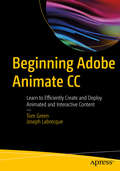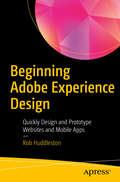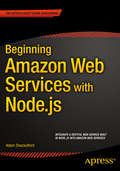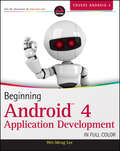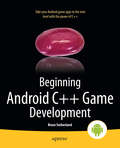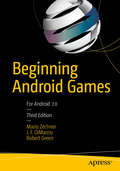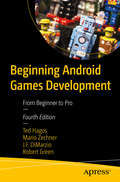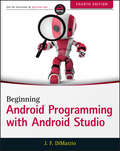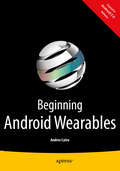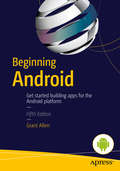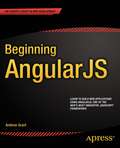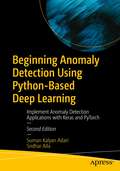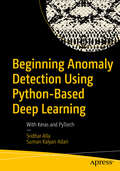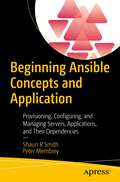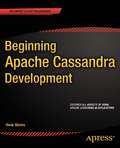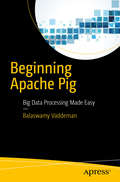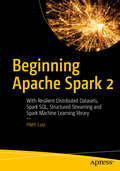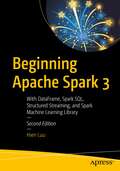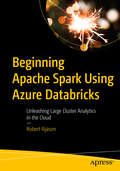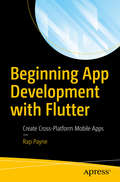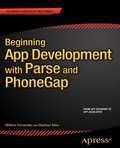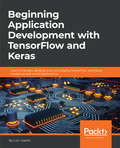- Table View
- List View
Beginning Ada Programming: From Novice to Professional
by Andrew T. ShvetsDiscover the Ada programming language by being gently guided through the various parts of the language and its latest available stable release. The goal in this book is to slowly ease you into the different topics. It is understood that you do not always have ample free time, so the text is easy to digest and concepts are spoon fed to the reader. Starting with the simplest of topics, detailed explanations demonstrate the how and why of Ada. You are strongly encouraged to experiment and break things (without which the learning process is linear and quite dull). At the end of Beginning Ada Programming, you will have an excellent understanding of the general topics that make up the Ada programming language and can tackle far more challenging topics. Each chapter builds on what was previously described. Furthermore, each code example is independent of others and will run all by itself. Instructions are provided where you can obtain an Ada compiler and how to debug your code. What You Will Learn Master basic types, control structures, procedures, and functions in AdaUse Ada arrays, records, and access typesImplement OO programming using AdaHandle the basics of I/O and interfacing with the operating systemTake advantage of string operators, data containers, multiprocessing with tasks, and moreWork with contracts and proofs, networks, and various Ada libraries Who This Book Is For Programmers who are new to Ada, with at least some experience in programming, especially scientific programming.
Beginning Adobe Animate CC: Learn to Efficiently Create and Deploy Animated and Interactive Content
by Joseph Labrecque Tom GreenUse solid and practical exercises to master the fundamentals of Adobe Animate CC. This is one of the first comprehensive books on Adobe Animate CC to thoroughly examine and demonstrate how to create and deploy interactive and motion design content to mobile, tablet, and desktop screens. Using a series of carefully developed tutorials, Beginning Adobe Animate CC will lead you from basic Animate CC document workflows to the point where you can create animations, interactive projects, and anything else using a variety of techniques. Each chapter focuses on a major aspect of Animate CC and then lets you take over with a series of "Your Turn" exercises that let you create amazing projects based on what you have learned. Beginning Adobe Animate CC focuses on the core skill set needed to master Animate CC and while you are at it, you will be guided to the mastery of the fundamentals, such as drawing tools, movie clips, video and audio content, text, graphics, external data, components, and a solid overview of the code you need to know to take your skills to the next level. What You Will Learn: Create and deploy animated and interactive content for the HTML 5 universe. Create images and vector graphics for use in Animate CC. Examine a variety of animation techniques that make full use of the Animate CC timeline. Add video and audio content to an Animate CC project. Use many of the graphic creation tools in Animate CC. Publish your projects to a variety of formats. Who This Book is For: Those who are proficient in creating and publishing animated and interactive web-based content. It will also help those who are proficient in using Adobe Flash Professional CC to understand the improvements and new workflows found in Adobe Animate CC.
Beginning Adobe Experience Design: Quickly Design and Prototype Websites and Mobile Apps
by Rob HuddlestonRender high quality designs and interactive prototypes of web sites and mobile apps using Adobe XD's powerful drawing and layout tools. This book provides an in-depth look at XD and shows you how to quickly get up-to-speed to simplify these processes with intuitive design tools and a powerful prototyping function. Since the advent of the web, designers have struggled with the need to create functioning demo prototypes of their layouts and designs without an extensive amount of code for their clients. The dawn of mobile apps, which are exponentially more difficult to mock-up and demonstrate, has only intensified this problem. Beginning Adobe Experience Design resolves this for you with it's easy-to-use approach to leveraging XD. What You'll LearnCreate links and interactivity to see just how your site or app will functionPreview your site or prototype live in a web browser or your mobile deviceUse Adobe XD on both Mac and WindowsWho This Book Is ForWeb front-end designers and user experience professionals and educators interested in teaching the tool
Beginning Amazon Web Services with Node.js
by Adam ShackelfordBeginning Amazon Web Services with Node. js teaches any novice Node. js developer to configure, deploy, and maintain scalable small to large scale Node. js applications in Amazon Web Services. Hosting a Node. js application in a production environment usually means turning to PaaS hosting, but this approach brings problems. Deploying Node. js directly to AWS solves the problems you encounter in these situations, enabling you to cut out the middle man. You will begin with a basic RESTful web service in Node. js, using the popular Express. js framework, pre-built and ready to run in your local environment. You will be introduced to the most powerful tools in AWS, and learn how to configure your project to take advantage of them. You will be guided through the steps of getting the various key components to work together on AWS. Through code samples using the AWS JavaScript SDK and tutorials in the AWS console, you will gain the knowledge to incorporate secure user authentication, server auto-scaling, a load balancer, CDN, customized caching behavior, and outage monitoring. Node. js is single-threaded, and designed to run high input / high output applications, making it ideal for the cloud environment. If your main task is handling a high volume of requests over HTTP / the web, it will scale very well in proportion to the computing power you allocate to it. Amazon Web Services offers a broad set of services that help organizations move faster, lower costs, and scale applications. Trusted by the largest enterprises and start-ups alike, AWS powers a wide variety of workloads across a broad spectrum. If leveraged properly, you can build a Node. js app on AWS which can automatically power itself up to handle a massive volume of traffic, and then scale back down to a lighter configuration when user demand has dropped. Amazon Web Services offers a broad set of services that help organizations move faster, lower costs, and scale applications. Get started with Node. js and AWS using this book today. What you'll learn â-- Using AWS Opsworks to architect and configure a secure web application built for hosting in the cloud. â-- Integrating AWS Cloudwatch, SES, and other AWS services into your code. â-- Using AWS Route 53 to configure your domain to use a load balancer, CDN, and other performance-enhancing services into your application. â-- Deploying with AWS Opsworks and using AWS services to monitor, scale, and maintain your application. Who this book is for This book is intended for a beginner/novice Node. js developer who has traditionally relied on PaaS services such as Heroku or Parse to host their web applications. This book aims to empower the reader to work directly in AWS, in order to manage their own infrastructure. Hosting a Node. js application in a production environment usually means turning to PaaS hosting such as Heroku or AppFog, but this approach brings problems. Deploying Node. js directly to AWS solves the problems you encounter in these situations, enabling you to cut out the middle man. If leveraged properly, you can build a Node. js app on AWS which can automatically power itself up to handle a massive volume of traffic, and then scale back down to a lighter configuration when user demand has dropped. Table of Contents 1. Getting Started with Amazon Web Services 2. Working with AWS OpsWorks 3. OpsWorks Part II: Databases and Scaling 4. CloudFront and DNS Management 5. Simple Storage Service and Content Delivery 6. Simple Email Service 7. Monitoring the Application 8. Securing The Application
Beginning Android 3D Game Development
by Robert ChinBeginning Androida3D Game Developmentais a unique book for today's Android and game app developers who want to learn how to build 3D game appsathat run on the latest Android KitKat platform using Java and OpenGL ES. aaAaDrone Grid game case study is included. "
Beginning Android Application Development
by Wei-Meng LeeCreate must-have applications for the latest Android OSThe Android OS is a popular and flexible platform for many of today's most in-demand mobile devices. This full-color guide offers you a hands-on introduction to creating Android applications for the latest mobile devices. Veteran author Wei Meng Lee accompanies each lesson with real-world examples to drive home the content he covers. Beginning with an overview of core Android features and tools, he moves at a steady pace while teaching everything you need to know to successfully develop your own Android applications.Explains what an activity is and reviews its lifecycleZeroes in on customizing activities by applying styles and themesLooks at the components of a screen, including LinearLayout, AbsoluteLayout, and RelativeLayout, among othersDetails ways to adapt to different screen sizes and adjust display orientationReviews the variety of views such as TextView, ProgressBar, TimePicker, and moreBeginning Android Application Development pares down the most essential steps you need to know so you can start creating Android applications today.
Beginning Android Application Development
by Wei-Ming LeeCreate must-have applications for the latest Android OS The Android OS is a popular and flexible platform for many of today's most in-demand mobile devices. This full-color guide offers you a hands-on introduction to creating Android applications for the latest mobile devices. Veteran author Wei Meng Lee accompanies each lesson with real-world examples to drive home the content he covers. Beginning with an overview of core Android features and tools, he moves at a steady pace while teaching everything you need to know to successfully develop your own Android applications. Explains what an activity is and reviews its lifecycle Zeroes in on customizing activities by applying styles and themes Looks at the components of a screen, including LinearLayout, AbsoluteLayout, and RelativeLayout, among others Details ways to adapt to different screen sizes and adjust display orientation Reviews the variety of views such as TextView, ProgressBar, TimePicker, and more Beginning Android Application Development pares down the most essential steps you need to know so you can start creating Android applications today.
Beginning Android C++ Game Development
by Bruce SutherlandBeginning Android C++ Game Development introduces general and Android game developers like you to Android's powerful Native Development Kit (NDK). The Android NDK platform allows you to build the most sophisticated, complex and best performing game apps that leverage C++. a In short, you learn to build professional looking and performing game apps like the book's case study, Droid Runner. In this book, you'll learn all the major aspects of game design and programming using the Android NDK and be ready to submit your first professional video game app to Google Play and Amazon Appstore for today's Android smartphones and tablet users to download and play. aThe techniques contained in this book include building a game engine, writing a renderer, and building a full game app with entities, game levels and collisions. As part of the tutorial you'll also learn about inserting perspectives using cameras and including audio in your game app. "
Beginning Android Games
by J. F. Dimarzio Mario Zechner Robert GreenBeginning Android Games offers everything you need to join the ranks of successful Android game developers. You'll start with game design fundamentals and programming basics, and then progress towards creating your own basic game engine and playable games. This will give you everything you need to branch out and write your own Android games. The potential user base and the wide array of available high-performance devices makes Android an attractive target for aspiring game developers. Do you have an awesome idea for the next break-through mobile gaming title? Beginning Android Games will help you kick-start your project. The book will guide you through the process of making several example games for the Android platform, and involves a wide range of topics: * The fundamentals of game development * The Android platform basics to apply those fundamentals in the context of making a game * The design of 2D and 3D games and their successful implementation on the Android platform What you'll learn * How to set up and use the development tools for developing your first Android application * The fundamentals of game programming in the context of the Android platform * How to use the Android's APIs for graphics (Canvas, OpenGL ES 1. 0/1. 1), audio, and user input to reflect those fundamentals * How to develop two 2D games from scratch, based on the Canvas API and OpenGL ES. * How to create a full-featured 3D game * How to publish your games, get crash reports, and support your users * How to complete your own playable 2D OpenGL games Who this book is for This book is for people with a basic knowledge of Java who want to write games on the Android platform. It also offers information for experienced game developers about the pitfalls and peculiarities of the platform. Table of Contents * Android, the New Kid on the Block * First Steps with the Android SDK * Game Development 101 * Android for Game Developers * An Android Game Development Framework * Mr. Nom Invades Android * OpenGL ES: A Gentle Introduction *2D Game Programming Tricks * Super Jumper: A 2D OpenGL ES Game * OpenGL ES: Going 3D *3D Programming Tricks * Droid Invaders: the Grand Finale * Publishing Your Game * What's Next?
Beginning Android Games Development: From Beginner to Pro
by Mario Zechner Robert Green Ted Hagos J.F. DiMarzioDo you have an awesome idea for the next break-through mobile gaming title? This updated edition will help you kick-start your project as it guides you through the process of creating several example game apps using APIs available in Android. You will learn the basics needed to join the ranks of successful Android game app developers. the book starts with game design fundamentals using Canvas and Android SDK 10 or earlier programming basics. You then will progress toward creating your own basic game engine and playable game apps that work on Android 10 or earlier smartphones and tablets. You take your game through the chapters and topics in the book to learn different tools such as OpenGL ES. And you will learn about publishing and marketing your games to monetize your creation.What You Will Learn Gain knowledge on the fundamentals of game programming in the context of AndroidUse Android's APIs for graphics, audio, and user input to reflect those fundamentals Develop two 2D games from scratch, based on Canvas API and OpenGL ES Create a full-featured 3D game Publish your games, get crash reports, and support your users Complete your own playable 2D OpenGL games Who This Book Is For Those with basic knowledge of Java who want to write games on the Android platform, and experienced game developers who want to know about the pitfalls and peculiarities of the platform
Beginning Android Programming with Android Studio
by Jerome F. DimarzioA hands-on introduction to the latest release of the Android OS and the easiest Android tools for developers As the dominant mobile platform today, the Android OS is a powerful and flexible platform for mobile device. The new Android 7 release (New York Cheesecake) boasts significant new features and enhancements for both smartphone and tablet applications. This step-by-step resource takes a hands-on approach to teaching you how to create Android applications for the latest OS and the newest devices, including both smartphones and tablets. Shows you how to install, get started with, and use Android Studio 2 - the simplest Android developer tool ever for beginners Addresses how to display notifications, create rich user interfaces, and use activities and intents Reviews mastering views and menus and managing data Discusses working with SMS Looks at packaging and publishing applications to the Android market Beginning Android Programming with Android Studio starts with the basics and goes on to provide you with everything you need to know to begin to successfully develop your own Android applications.
Beginning Android Wearables: With Android Wear and Google Glass SDKs
by Andres CalvoBeginning Android Wearables gives you the skills you need to make effective apps for Android Wear-based smartwatches, fitness bracelets, connected home wearable controllers, and Google Glass. Delight your users by giving them access to the information they'll need at the tips of their fingers. This book is very practical and contains many examples that not only show you how to write code for Glass and Android Wear, but also demonstrate how to apply this code in the context of an app. What you'll learn Build notifications for handheld apps that are automatically shared with wearables, and learn to customize these notifications Create apps that run directly on Android Wear devices and leverage the Android Wear SDK Use the wearable UI library to build effective user interfaces for Android Wear Use the wearable data layer API to share and synchronize data between a handheld device and Android Wear Build custom watch faces for Android Wear Build Glassware (that is, apps for Glass) using the Glass Development Kit (GDK) Utilize location providers and orientation sensors to build contextually sensitive apps Who this book is for This book only requires basic knowledge of Android programming. Prior to this book, you should have read or are at least comfortable with Android after using Apress tutorials, Android Apps for Absolute Beginners or Beginning Android. Table of Contents Part I - Introduction 1. Introducing Android Wearables Part II - Notifications 2. Reviewing Notifications for Android 3. Customizing Notifications for Wearables Part III - Android Wear 4. Running Apps Directly on Android Wear 5. Android Wear UI Essentials 6. The Wearable Data Layer API 7. Creating Custom Watch Faces Part IV - Google Glass 8. Running Apps Directly on Glass 9. Glass User Interface Essentials 10. Voice and Input 11. The Camera: Taking Pictures and Recording Video Part V - Android Wear and Glass 12. Location and Orientation
Beginning Android: Develop For Android Using Html5, Css3, And Javascript
by Grant AllenGet started in creating marketable apps for the burgeoning Android market. Begin your journey by learning the essentials of programming for phones and tables that are built around Google's wildly-successful Android platform. Beginning Android, Fifth Edition is fresh with details on the latest iteration of the Android 5 and earlier versions. Google's Android operating-system has taken the industry by storm, going from its humble beginnings as a smartphone operating system to its current status as a platform for apps that run across a gamut of devices from phones to tablets to netbooks to televisions, and the list is sure to grow. Smart developers are not sitting idly by in the stands, but are jumping into the game of creating innovative and salable applications for this fast-growing, mobile- and consumer-device platform. If you're not in the game yet, now is your chance! Begin at the beginning by installing the tools and compiling a skeleton app. Move through creating layouts, employing widgets, taking user input, and giving back results. Soon you'll be creating innovative applications involving multi-touch, multi-tasking, and more! You'll be drawing data live from the Internet using web services and delighting your customers with life-enhancing apps. Not since the PC era first began has there been this much opportunity for the common developer. What are you waiting for? Grab your copy of Beginning Android and get started! What you'll learn Develop Java-based mobile applications and games for a wide range of phones and devices. Create user interfaces using WebKit and the Android widget framework. Incorporate activities, services, content providers, and broadcast receivers into your applications. Support multiple Android versions, multiple screen sizes, and other device-specific characteristics. Build and experience the array of new WebM video and other multimedia APIs for Android and more. Who this book is for Beginning Android is aimed at programmers new to Android application development who desire to create marketable applications for the burgeoning market of smartphone, tablet, and other Android device users. Table of Contents Part I: Get Android and Get Coding! 1. Welcome to Android 2. Ready, Set, Code! 3. Inside Your First Android Project 4. Changing and Improving Your Project Part II: Activities and the User Interface 5. Layouts and UI Design 6. Android Widgets 7. Containers, Lists, and Adapters 8. Input Methods, Fonts, Menus, and Dialogs 9. The Action Bar 10. The Lifecycle of an Activity III: A World of Wonderful Devices and Screens 11. Devices of All Sizes 12. Phone Calls! 13. Audio and Sound Support 14. Image and Video Handling 15. A Device of Devices IV: Working with Resources and Services 16. Working with Files 17. Working with Local Databases 18. Working with Preferences 19. Controlling Security and Permissions 20. More Power from Java Libraries 21. Using External Libraries 22. Calling on Services 23. Generating Notifications
Beginning AngularJS
by Andrew GrantBeginning AngularJS is your step-by-step guide to learning the powerful AngularJS JavaScript framework. AngularJS is one of the most respected and innovative frameworks for building properly structured, easy-to-develop web applications. This book will teach you the absolute essentials, from downloading and installing AngularJS, to using modules, controllers, expressions, filters, and directives. Unlike many other books, you don't need experience with AngularJS or deep JavaScript knowledge to get started here. This book will begin by teaching you the JavaScript you need to know, and then you'll get into the basics of AngularJS. You'll learn powerful AngularJS techniques through clear instructions. With what you learn you'll be able to properly structure your code into manageable modules, understand the MVC design patterns, create expressive and adaptive HTML forms, communicate with servers and use other AngularJS services, use the powerful built-in directives, and learn how to create your own. This might all seem unknown now, but with this book you'll understand it all. AngularJS is a powerful framework, and one which may require you to think a little differently. This book will help you avoid the common pitfalls and get you up to speed, and building solid AngularJS applications, quickly and painlessly.
Beginning Anomaly Detection Using Python-Based Deep Learning: Implement Anomaly Detection Applications with Keras and PyTorch
by Sridhar Alla Suman Kalyan AdariThis beginner-oriented book will help you understand and perform anomaly detection by learning cutting-edge machine learning and deep learning techniques. This updated second edition focuses on supervised, semi-supervised, and unsupervised approaches to anomaly detection. Over the course of the book, you will learn how to use Keras and PyTorch in practical applications. It also introduces new chapters on GANs and transformers to reflect the latest trends in deep learning. Beginning Anomaly Detection Using Python-Based Deep Learning begins with an introduction to anomaly detection, its importance, and its applications. It then covers core data science and machine learning modeling concepts before delving into traditional machine learning algorithms such as OC-SVM and Isolation Forest for anomaly detection using scikit-learn. Following this, the authors explain the essentials of machine learning and deep learning, and how to implement multilayer perceptrons for supervised anomaly detection in both Keras and PyTorch. From here, the focus shifts to the applications of deep learning models for anomaly detection, including various types of autoencoders, recurrent neural networks (via LSTM), temporal convolutional networks, and transformers, with the latter three architectures applied to time-series anomaly detection. This edition has a new chapter on GANs (Generative Adversarial Networks), as well as new material covering transformer architecture in the context of time-series anomaly detection. After completing this book, you will have a thorough understanding of anomaly detection as well as an assortment of methods to approach it in various contexts, including time-series data. Additionally, you will have gained an introduction to scikit-learn, GANs, transformers, Keras, and PyTorch, empowering you to create your own machine learning- or deep learning-based anomaly detectors. What You Will Learn Understand what anomaly detection is, why it it is important, and how it is appliedGrasp the core concepts of machine learning.Master traditional machine learning approaches to anomaly detection using scikit-kearn.Understand deep learning in Python using Keras and PyTorchProcess data through pandas and evaluate your model's performance using metrics like F1-score, precision, and recallApply deep learning to supervised, semi-supervised, and unsupervised anomaly detection tasks for tabular datasets and time series applications Who This Book Is For Data scientists and machine learning engineers of all levels of experience interested in learning the basics of deep learning applications in anomaly detection.
Beginning Anomaly Detection Using Python-Based Deep Learning: With Keras and PyTorch
by Sridhar Alla Suman Kalyan AdariUtilize this easy-to-follow beginner's guide to understand how deep learning can be applied to the task of anomaly detection. Using Keras and PyTorch in Python, the book focuses on how various deep learning models can be applied to semi-supervised and unsupervised anomaly detection tasks.This book begins with an explanation of what anomaly detection is, what it is used for, and its importance. After covering statistical and traditional machine learning methods for anomaly detection using Scikit-Learn in Python, the book then provides an introduction to deep learning with details on how to build and train a deep learning model in both Keras and PyTorch before shifting the focus to applications of the following deep learning models to anomaly detection: various types of Autoencoders, Restricted Boltzmann Machines, RNNs & LSTMs, and Temporal Convolutional Networks. The book explores unsupervised and semi-supervised anomaly detection along with the basics of time series-based anomaly detection.By the end of the book you will have a thorough understanding of the basic task of anomaly detection as well as an assortment of methods to approach anomaly detection, ranging from traditional methods to deep learning. Additionally, you are introduced to Scikit-Learn and are able to create deep learning models in Keras and PyTorch.What You Will LearnUnderstand what anomaly detection is and why it is important in today's worldBecome familiar with statistical and traditional machine learning approaches to anomaly detection using Scikit-LearnKnow the basics of deep learning in Python using Keras and PyTorchBe aware of basic data science concepts for measuring a model's performance: understand what AUC is, what precision and recall mean, and moreApply deep learning to semi-supervised and unsupervised anomaly detectionWho This Book Is ForData scientists and machine learning engineers interested in learning the basics of deep learning applications in anomaly detection
Beginning Ansible Concepts and Application: Provisioning, Configuring, and Managing Servers, Applications, and Their Dependencies
by Peter Membrey Shaun R SmithLearn the concepts and develop the skills to be a true Ansible artist and use it inside and outside the box. This book applies key concepts immediately while building up your Ansible skills layer by layer through easy to grasp examples and engaging projects. You’ll also think about security, why testing is important, and how to use version control safely.As a beginner to Ansible, you'll be guided step-by-step through creating your first Ansible playbook to deploying your first server and writing more complex cross-dependency playbooks. From the first line of code to the last, you'll constantly iterate and simplify your playbooks, iwhile taking on more complex topics as you construct a full Wordpress website stack consisting of a database, web servers, and load balancer. This book will prompt you to think about how these fit together and will explain what to do to ensure maintainability long into the future. Don’t just use Ansible. Completely change how you go about provisioning, configuring, and managing servers, applications, and their dependencies with this powerful, open source automation tool. In exchange for this power and efficiency, Ansible demands a very different way of thinking about resources and how they all fit together. This can be hard to get your head around if you’ve never done it before. Every step of the way, Beginning Ansible Concepts and Application show you best practices so that you can confidently start using Ansible right away.What You'll LearnSet up an Ansible environmentCreate and run playbooksOrganize groups of variables, vaults, roles, and tasks to ensure your playbooks are scalableProtect secrets using Ansible VaultsAutomate the build of a Wordpress websiteWho This Book Is For Developers looking for a better way to manage their servers other than by logging in and typing commands. Also enthusiasts who want to learn not just how to use Ansible but how to use it correctly and confidently.
Beginning Apache Cassandra Development
by Vivek MishraBeginning Apache Cassandra Development introduces you to one of the most robust and best-performing NoSQL database platforms on the planet. Apache Cassandra is a document database following the JSON document model. It is specifically designed to manage large amounts of data across many commodity servers without there being any single point of failure. This design approach makes Apache Cassandra a robust and easy-to-implement platform when high availability is needed. Apache Cassandra can be used by developers in Java, PHP, Python, and JavaScript--the primary and most commonly used languages. In Beginning Apache Cassandra Development, author and Cassandra expert Vivek Mishra takes you through using Apache Cassandra from each of these primary languages. Mishra also covers the Cassandra Query Language (CQL), the Apache Cassandra analog to SQL. You'll learn to develop applications sourcing data from Cassandra, query that data, and deliver it at speed to your application's users. Cassandra is one of the leading NoSQL databases, meaning you get unparalleled throughput and performance without the sort of processing overhead that comes with traditional proprietary databases. Beginning Apache Cassandra Development will therefore help you create applications that generate search results quickly, stand up to high levels of demand, scale as your user base grows, ensure operational simplicity, and--not least--provide delightful user experiences.
Beginning Apache Pig: Big Data Processing Made Easy
by Balaswamy VaddemanLearn to use Apache Pig to develop lightweight big data applications easily and quickly. This book shows you many optimization techniques and covers every context where Pig is used in big data analytics. Beginning Apache Pig shows you how Pig is easy to learn and requires relatively little time to develop big data applications. The book is divided into four parts: the complete features of Apache Pig; integration with other tools; how to solve complex business problems; and optimization of tools. You'll discover topics such as MapReduce and why it cannot meet every business need; the features of Pig Latin such as data types for each load, store, joins, groups, and ordering; how Pig workflows can be created; submitting Pig jobs using Hue; and working with Oozie. You'll also see how to extend the framework by writing UDFs and custom load, store, and filter functions. Finally you'll cover different optimization techniques such as gathering statistics about a Pig script, joining strategies, parallelism, and the role of data formats in good performance. What You Will Learn * Use all the features of Apache Pig * Integrate Apache Pig with other tools * Extend Apache Pig * Optimize Pig Latin code * Solve different use cases for Pig Latin Who This Book Is For All levels of IT professionals: architects, big data enthusiasts, engineers, developers, and big data administrators
Beginning Apache Spark 2
by Hien LuuDevelop applications for the big data landscape with Spark and Hadoop. This book also explains the role of Spark in developing scalable machine learning and analytics applications with Cloud technologies. Beginning Apache Spark 2 gives you an introduction to Apache Spark and shows you how to work with it.Along the way, you’ll discover resilient distributed datasets (RDDs); use Spark SQL for structured data; and learn stream processing and build real-time applications with Spark Structured Streaming. Furthermore, you’ll learn the fundamentals of Spark ML for machine learning and much more. After you read this book, you will have the fundamentals to become proficient in using Apache Spark and know when and how to apply it to your big data applications. What You Will Learn Understand Spark unified data processing platformHow to run Spark in Spark Shell or Databricks Use and manipulate RDDs Deal with structured data using Spark SQL through its operations and advanced functionsBuild real-time applications using Spark Structured StreamingDevelop intelligent applications with the Spark Machine Learning libraryWho This Book Is ForProgrammers and developers active in big data, Hadoop, and Java but who are new to the Apache Spark platform.
Beginning Apache Spark 3: With DataFrame, Spark SQL, Structured Streaming, and Spark Machine Learning Library
by Hien LuuTake a journey toward discovering, learning, and using Apache Spark 3.0. In this book, you will gain expertise on the powerful and efficient distributed data processing engine inside of Apache Spark; its user-friendly, comprehensive, and flexible programming model for processing data in batch and streaming; and the scalable machine learning algorithms and practical utilities to build machine learning applications. Beginning Apache Spark 3 begins by explaining different ways of interacting with Apache Spark, such as Spark Concepts and Architecture, and Spark Unified Stack. Next, it offers an overview of Spark SQL before moving on to its advanced features. It covers tips and techniques for dealing with performance issues, followed by an overview of the structured streaming processing engine. It concludes with a demonstration of how to develop machine learning applications using Spark MLlib and how to manage the machine learning development lifecycle. This book is packed with practical examples and code snippets to help you master concepts and features immediately after they are covered in each section. After reading this book, you will have the knowledge required to build your own big data pipelines, applications, and machine learning applications.What You Will LearnMaster the Spark unified data analytics engine and its various componentsWork in tandem to provide a scalable, fault tolerant and performant data processing engineLeverage the user-friendly and flexible programming model to perform simple to complex data analytics using dataframe and Spark SQLDevelop machine learning applications using Spark MLlibManage the machine learning development lifecycle using MLflowWho This Book Is ForData scientists, data engineers and software developers.
Beginning Apache Spark Using Azure Databricks: Unleashing Large Cluster Analytics in the Cloud
by Robert IlijasonAnalyze vast amounts of data in record time using Apache Spark with Databricks in the Cloud. Learn the fundamentals, and more, of running analytics on large clusters in Azure and AWS, using Apache Spark with Databricks on top. Discover how to squeeze the most value out of your data at a mere fraction of what classical analytics solutions cost, while at the same time getting the results you need, incrementally faster. This book explains how the confluence of these pivotal technologies gives you enormous power, and cheaply, when it comes to huge datasets. You will begin by learning how cloud infrastructure makes it possible to scale your code to large amounts of processing units, without having to pay for the machinery in advance. From there you will learn how Apache Spark, an open source framework, can enable all those CPUs for data analytics use. Finally, you will see how services such as Databricks provide the power of Apache Spark, without you having to know anything about configuring hardware or software. By removing the need for expensive experts and hardware, your resources can instead be allocated to actually finding business value in the data. This book guides you through some advanced topics such as analytics in the cloud, data lakes, data ingestion, architecture, machine learning, and tools, including Apache Spark, Apache Hadoop, Apache Hive, Python, and SQL. Valuable exercises help reinforce what you have learned. What You Will Learn Discover the value of big data analytics that leverage the power of the cloudGet started with Databricks using SQL and Python in either Microsoft Azure or AWSUnderstand the underlying technology, and how the cloud and Apache Spark fit into the bigger picture See how these tools are used in the real world Run basic analytics, including machine learning, on billions of rows at a fraction of a cost or free Who This Book Is ForData engineers, data scientists, and cloud architects who want or need to run advanced analytics in the cloud. It is assumed that the reader has data experience, but perhaps minimal exposure to Apache Spark and Azure Databricks. The book is also recommended for people who want to get started in the analytics field, as it provides a strong foundation.
Beginning App Development with Flutter: Create Cross-Platform Mobile Apps
by Rap PayneCreate iOS and Android apps with Flutter using just one codebase. App development on multiple platforms has historically been difficult and complex. This book breaks down complex concepts and tasks into easily digestible segments with examples, pictures, and hands-on labs with starters and solutions. In doing so, you'll develop a basic understanding of the Dart programming language; the entire Flutter development toolchain; the differences between stateful and stateless widgets; and a working knowledge of the architecture of apps. All the most important parts of app development with Flutter are covered in this book. Work with themes and styles. Develop custom widgets. Teach your app to respond to gestures like taps, swipes, and pinches. Design, create and control the layout of your app. Create tools to handle form data entry from users. And ultimately create killer multiscreen apps with navigation, menus, and tabs.Flutter is Google's new framework for creating mobile apps that run on iOS and Android phones both.You had to be a super-developer to write apps for iOS or Android alone. But writing for both? Forget about it! You had to be familiar with Swift, Java/Kotlin, Xcode, Eclipse, and a bunch of other technologies simultaneously. Beginning App Development with Flutter simplifies the entire process.What You'll Learn Get the most out of great Flutter widgets Create custom widgets, both stateless and statefulExercise expert control over your Flutter layoutsMake your app respond to gestures like swiping, pinching and tappingInitiate async Ajax calls to RESTful APIs — including Google Firebase!Who This Book Is ForDevelopers who have coded in Java, C#, C++, or any similar language. It brings app development within the reach of younger developers, so STEM groups are likely to pick up the technology. Managers, product owners, and business analysts need to understand Flutter's capabilities.
Beginning App Development with Parse and Phonegap
by Wilkins Fernandez Stephan AlberBeginning App Development with Parse and PhoneGap teaches you how to start app development with Parse and PhoneGap: free and open source software. Using the building block languages of the web--HTML, JavaScript, and CSS--you'll be on your way to creating a fully working product with minimal effort as fast as possible. With over 25 years' of combined experience, the authors make daunting tasks seem trivial. There is no book on the market that can take you from designer to developer faster. Using Facebook's Parse as backend service, and Adobe's PhoneGap (or Cordova) as a mobile development framework, building a highly customizable application is easier than you can imagine. A basic understanding of JavaScript, HTML, and CSS is not required, but it will help you pick up concepts faster. This book is geared toward a designer who wants to explore the world of application development. If you do not know anything about design, that's OK! We will walk you through step by step on how to build your first native iOS or Android app in the fastest and easiest way possible. Using free and open source software, this book will get you up and running quickly and efficiently--start using Parse and PhoneGap today with this key title. What you'll learn â-- How to get your environment set up for application development â-- Create an online Data Storage using Parse â-- Essential basics of Querying a Database: Create, Remove, Update and Delete Data â-- Use advanced native phone features like geolocation and camera access â-- How to organize your code for maximum efficiency â-- Release your application to the world online Who this book is for Beginning App Development with Parse and PhoneGap is intended for a designer or novice developer that wants to take their skills to the next level. You do not need deep knowledge of HTML, CSS, or JavaScript, but you'll be working with all of them. Using free and open source software - Parse and PhoneGap - you'll be able to get started straight away. Table of Contents 1. Introduction 2. Beginning PhoneGap 3. Beginning Parse 4. Tools and Helpers 5. Facebook API 6. The Messenger Application 7. User Registration with Parse 8. Messages 9. Location Services 10. Map Views 11. Accessing and Sharing Photos 12. Network Connection Status
Beginning Application Development with TensorFlow and Keras: Learn to design, develop, train, and deploy TensorFlow and Keras models as real-world applications
by Luis CapeloLearn to design, develop, train, and deploy TensorFlow and Keras models as real-world applicationsKey Features- Focus on neural network and its essential operations- Prepare data for a deep learning model and deploy it as an interactive web application, with Flask and a HTTP API- Use Keras, a TensorFlow abstraction library Book DescriptionWith this book, you’ll learn how to train, evaluate and deploy Tensorflow and Keras models as real-world web applications. After a hands-on introduction, you’ll use a sample model to explore the details of deep learning, selecting the right layers that can solve a given problem. By the end of the course, you’ll build a Bitcoin application that predicts the future price, based on historic, and freely available information.This book will also provide you with a blueprint for how to build an application that generates predictions using a deep learning model. From there, you can continue to improve our example model— either by adding more data, computing more features, or changing its architecture—continuously increasing its prediction accuracy, or create a completely new model, changing the core components of the application as you see fit. What you will learn- Set up a deep learning programming environment - Explore the common components of a neural network and its essential operations- Prepare data for a deep learning model- Deploy model as an interactive web application, with Flask and a HTTP API- Use Keras, a TensorFlow abstraction library - Explore the types of problems addressed by neural networksWho this book is forThis course is ideal for experienced developers, analysts, or a data scientists, who want to develop applications using TensorFlow and Keras. This rapid hands-on course quickly shows you how to get to grips with TensorFlow in the context of real-world application development. We assume that you are familiar with Python and have a basic knowledge of web application development. If you have a background in linear algebra, probability, and statistics, you will easily grasp concepts that are discussed in the course.
